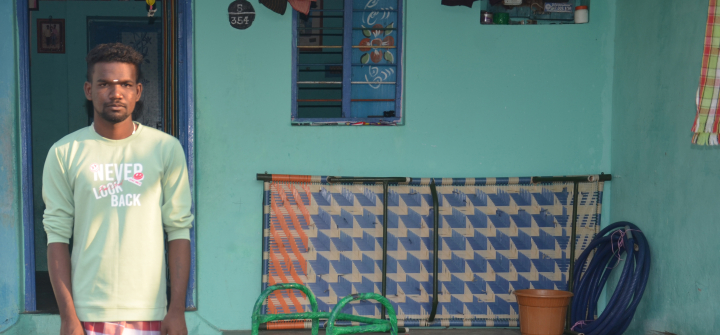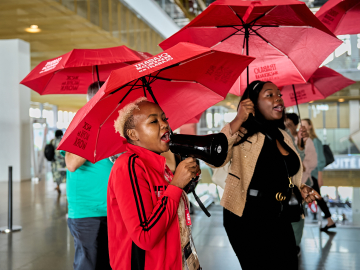Fireworks and Heartbreak in a Hard-Hit Indian Village
SIVAKASI, India—Of the 650 families who live in Surangudi village, most have lost either a limb or a loved one to fireworks, says Vijay Kumar, a social activist and director of the Human Resource Foundation, a small NGO that aids fireworks factory victims in this area.
The fireworks industry is the biggest employer in and around Sivakasi. Tens of thousands of workers from the area produce some 50,000 tons of firecrackers annually—most of India's fireworks. But they also risk deadly fires and explosions in their work.
“For most people, fireworks mean joy,” Kumar says. “But for those whose lives are so closely associated with it, it’s a source of sorrow and heartbreak.”
In addition to much-needed wages for its people, the village of Surangudi has reaped more than its share of sorrow.
A Deadly Blast
Four years ago, Surangudi resident Muthukutti, 23, was working at Sree Mariyammal Fireworks Factory in Achangulam village, roughly 20 kilometers (12 miles) from Sivakasi.
An explosion, on February 12, 2021, at 1:30 p.m., killed 19 people at the factory, and eight others died later in the hospital. Dozens more were injured. It is considered one of the deadliest blasts in the area’s history of fireworks manufacturing. Many of those killed and injured in Surangudi village were Dalits, some of the most-oppressed castes in the ancient system of discrimination and social hierarchy.
Muthukutti, a Dalit who goes by his first name, remembers that in the first instant of the explosion, a firecracker shot into the air and tore into the flesh of his left leg, just his below his knee.
When he awoke, doctors told him he had badly severed nerves that would heal. But days later, they told him he had necrotizing fasciitis, a potentially life-threatening bacterial infection that can occur after a burn injury. For Muthukutti to survive, his left leg had to be amputated below the knee.
His aunt, Shanmugavadivu, also worked in the Sree Mariyammal factory and was injured in the explosion. The 60-year-old, also a Dalit, had third-degree burns on her chest, stomach, arms, and legs. She has had two skin-graft surgeries, but healing has been slow, and the pain excruciating. While she received an initial ~$1,160 (INR 100,000) compensation payment from Tamil Nadu state government’s Chief Minister Relief Fund—the same amount that Muthukutti received—it hasn’t been enough to cover the skyrocketing medical expenses. Her son, who works as a supervisor in the construction industry, currently pays for her treatment.

Shamugavadivu, also worked in the Sree Mariyammal factory and suffered third-degree burns on her chest, stomach, arms, and legs during the explosion. Kamala Thiagarajan
“My body feels like it’s trapped in a prison of pain,” she says. “There are many things I can’t do. The accident robbed me of my ability to live my life freely. I am afraid of harsh sunlight and of contracting an infection, so I must stay indoors.”
Workers aren’t the only ones harmed by the fireworks factory blasts and fires: Their family members routinely suffer as well. Jeyarani, 38, lost her husband Michael Raj, the family’s primary bread winner, in the 2021 blast. Life for her and her two children changed irrevocably.
“Overnight, I had to support my family, while grieving the loss of my husband,” she says. “The pain and stress of those years have left scars even on the uninjured.”
The Ongoing Danger
The most-frequent victims of fireworks factory accidents are often Dalits, who have long been oppressed. “Many of the victims who tragically burned to death in that accident, and those who still toil away in fireworks factories have one thing in common—they’re Dalits,” says S. Karuppiah, the president of the Dalit Vidudhalai Iyakkam (Dalit Liberation Movement), a political organization fighting for the rights of Dalit workers.
Among those who died in the Sree Mariyammal fireworks accident that scarred the people of Muthukutti’s village were a pregnant woman and a 15-year-old student. Both were Dalits. Over the years, members of the Dalit Liberation Movement have arranged local protests and filed numerous public interest lawsuits. Factory owners consistently fail to take responsibility, says Karuppiah.
The factory owner in this case did provide victims like Shanmugavadivu with checks—but all of them bounced.
The ongoing dangerous conditions at fireworks factories in the Sivakasi have two major sources, Karuppiah says. First, workers have no rights or benefits like basic health insurance or a retirement savings plan—and few other options for employment.
“They keep returning to fireworks factories, even after being hurt, because there is nowhere else to turn to if you want to make a living,” he says.
Second, factory owners illegally lease their sites to others—“many of whom flout safety measures and skimp on safety equipment,” Karuppiah says. Illegal leasing, for example, had preceded the Sree Mariyammal factory explosion.
Fires and explosions in the factories can be prevented with simple measures, says R. Vignesh, a fire safety expert and project manager at Industrial Safety Enterprises, a Madurai-based company. Automated industrial water sprinklers that are activated when they detect smoke or heat could save lives by preventing secondary explosions, Vignesh says. “The current regulations only stipulate fire extinguishers or a bucket of water, both of which are useless considering the scale of the blast,” Vignesh says.
For many factory owners, changes like adding sprinklers are affordable. The sprinklers would cost factory owners an average of ~$3,500 (INR 300,000) to install, he says.
“For every 10 rupees a manufacturer invests in fireworks, they get a return of 10 times that amount,” says Vijay Kumar. “And yet, there’s no accounting for human greed.”
Owners of factories can file insurance claims for their losses following an accident, he says, but there’s a lack of long-term care for victims. So, many of them are forced to return to work in the very factories where they were injured.
Years-Long Fight for Compensation
Soon after Muthukutti, 23, received his first compensation payment from the state, he received more encouraging news. The New Delhi-based National Green Tribunal, a government judicial body that protects a citizen’s legal rights after environmental disasters and accidents, set up an eight-member team to investigate the extent of damages. In a June 11, 2021, order, the NGT directed the state government, federal government, and the factory owner to pay damages within a month for negligence because of the lack of enforcement of fire safety regulations. The court decided the payouts: Those who had lost loved ones were entitled to $23,250 (INR 2,000,000); those with burns on 50% or more of their bodies would be paid Rs $17,450 (INR 15,000,000); and those with 25–50% burns on their bodies were entitled to $11,600 (INR 10,000,000).
But years later, Muthukutti and victims who live in the village of Surangudi are still waiting for compensation. They have received the payouts from the state and federal governments, but the factory owners still haven’t paid the bulk of the payment.
The payouts have been hindered because of a delay in liquidating the firework factory’s assets, says a lawyer who is representing some of the victims in court and who prefers not to be named because of ongoing litigation. The Tamilnadu Fireworks and Amorces Manufacturers’ Association (TANFAMA), the local fireworks manufacturers’ powerful advocacy organization, challenged the NGT ruling in the Supreme Court.
Bhima Rao, an activist and social worker petitioning the court on behalf of the injured victims, claims that many fireworks manufacturers have strong political connections and sought to quash the NGT order for compensation because they fear having to pay for hefty damages in this case and future cases.
“No one remembers the plight of the humble worker unless it’s election time,” Rao says. “Otherwise, the narrative is set by factory owners. They call all the shots.”
In March 2022, the TANFAMA argued that the 2021 NGT order would affect more than 1,000 fireworks manufacturers in and around Sivakasi, however, the Supreme Court dismissed the appeal, stating that Sree Mariyammal fireworks was not a member of the TANFAMA .
The owners of Sree Mariammal Fireworks could not be reached for comment, and TANFAMA did not respond to Global Health NOW’s request for comment
If Muthukutti ever receives compensation, it will likely be the lowest amount—$12,000—because he doesn’t have severe burns, though he suffered other major injuries, including the loss of his left leg, resulting from the explosion.
No Happy Endings
Outside his home in Surangudi, with its narrow, winding mud paths and thorny scrub plants that thrive in the blazing sunshine, Muthukutti is learning to live with his disability. He has a lime-green walker that he uses to steady himself as he hops forward on his right leg. He wears a pale green long sleeve t-shirt with the cuffs pushed up to his forearms. Emblazoned on the shirt’s front is “Never Look Back.
Muthukutti has taken another job at a fireworks factory, but this time he won’t handle chemicals. Instead, he’s making the outer shell of the firecracker and stuffing one end of the cardboard casing with mud.
He hopes to someday be able to afford a prosthetic limb.
“Everyone on this street is living with a scar—they’ve either encountered the emotional anguish over the loss of a loved one, or are living with immense physical suffering,” says Muthukutti. “We all have our stories, but there are no happy endings.”
Ed. Note: Our thanks go to Padmavathy Krishna Kumar shared the idea for this issue and received an honorable mention in the 2025 Untold Global Health Stories of contest, co-sponsored by Global Health NOW and the Consortium of Universities for Global Health.
Read “‘Invisible Suffering’: Deadly Risks in India’s Fireworks Factories,” the first part of this series.
Join the 50,000+ subscribers in 170+ countries who rely on Global Health NOW summaries and exclusive articles for the latest public health news. Sign up for our free weekday newsletter, and please share the link with friends and colleagues.
Muthukutti, 23, endured an amputation of his left leg after an accident at Sree Mariyammal Fireworks Factory in Achangulam village, outside Sivakasi, India. Kamala Thiagarajan




